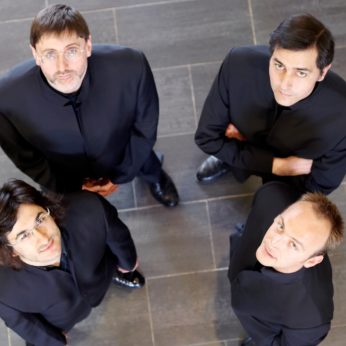There are many contemporary eye-witness reports of Shostakovich at his desk. He preferred to use an old steel nib pen and an inkwell. He would place a large sheet of manuscript paper in front of him and with scarcely a hesitation and practically no corrections, he would create his new scores. It looked to observers as if he was just copying down sounds heard in his innermost self, he would even write out the orchestral parts himself saying that everyone should do his work from beginning to end. He could not bear not to be working. The composer, Edison Denison, once found him writing furiously and was asked to wait. When he had the score completed, he tore it into tiny pieces and threw it away. Denison was horrified and remonstrated. Shostakovich replied that he was having trouble composing but could not sit around without working; so he was orchestrating a complete volume of Rimsky-Korsakov’s Songs one by one and tearing them up as soon as he finished each one.
Nina, his first wife, would have been fifty in 1960 and the fifth decade is concealed in the germ cell that opens the work. The three-bar phrase that remains within the span of a single octave is repeated five times. In this movement he seems to have determined to remember her as she was alive rather than write a dramatic elegy, for though this movement is highly charged it is neither sad nor emotional. There is a delightful episode where the first violin and cello, female and male voices, converse with each other, mostly pizzicato in the key of E-flat and reminiscent of the lovers in Die Zauberflöte. One suspects many other private musical references. One of the excitements of this work, in particular this movement, is its extreme brevity. On the whole he tends to spread himself but this work shows his gift for concision, where he packs a huge amount of material into a small space without seeming to constrain himself.
After the return of the first theme, the Allegretto soon slows down, drifts to a brief pause and the music flows into the Lento, where self-restraint is again the talisman. With the exception of six bars the entire movement is written in two or three parts only. The theme has a quiet and reflective beauty, little wonder that the composer often referred to it as his favourite quartet. It is accompanied by a semiquaver figure that recalls Pimen’s writing music in Act I of Boris Godunov or maybe even Der Einsame in Herbst from Mahler’s Das Lied von der Erde. After an eternity of only three and a half minutes the Finale comes barging in and after initial hesitation embarks on a terrifyingly wild fugue. Brevity is again the password and suddenly it is over to be replaced by a very strange waltz-like Allegretto, whose melody is a transformation of the fugue subject but whose mood is nearer to the slow movement with exchanges between individual instruments. The pizzicato conversation from the first movement is recalled and suddenly it is all over.
